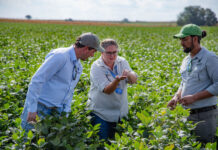Crop monitoring involves the increasing adoption of remote sensing and the Internet of Things (IoT) by farmers to optimize their crop yields and promote sustainable agriculture through crop monitoring and data-driven decision-making. Technologies such as artificial intelligence (AI), cloud machine learning, satellite imagery, and advanced analytics are empowering farmers owning small farmlands to increase their income through higher crop yields and greater price control. The use of GPS technology has helped farmers employ precision tools to improve efficiency in terms of inputs and enhance profitability by lowering variable cost and producing high crop yields. Based on technology, the crop monitoring market has been segmented into sensing and imagery technology, variable rate technology (VRT), and automation & robotics technology. Sensing and imagery technology is implemented through the use of satellites, drones, ground-based sensors, and telematics. Sensing and imagery technology holds the largest share of the crop monitoring market as innovations in remote sensing and connected farming methods, along with the penetration of smartphones have boosted the demand for sensing and monitoring technology. The use of drones in crop monitoring has too paved a way for the growth of this technology.
The crop monitoring market is expected to grow further due to the growing adoption of smart agriculture, IoT devices, global positioning system (GPS), and remote sensing technologies by farmers/growers. The crop monitoring market is expected to grow from USD 2.2 billion in 2020 to USD 4.4 billion by 2025, at a CAGR of 15.2%.
Increasing concerns for high yield, farmers’ profitability, food safety, and traceability is driving the growth of crop monitoring market. The growing population across the world, limited arable land, depleting resources, and climate change and environmental impact has raised concerns for high agricultural yield across the world. The population of the world is expected to reach about 9.8 billion by 2050 as per the estimates provided by the United Nations. In order to feed this huge population, it has become essential to increase the per hectare output across the world. The per hectare output in several developing countries in Asia Pacific and Africa is considerably low and hence, there is a need to improve the yield per hectare. Apart from this, the land available for agriculture is shrinking and the resources are being depleted, which puts an additional burden on countries to increase the agricultural produce. Digital agriculture has an untapped potential, which can impact the agriculture sector considerably. Digitalization in agriculture helps farmers to gather critical data from their farms, which provides meaningful insights to take corrective actions on time, improves farm operations and management. The generated data can help the farmers to take data-based operational decisions, which ultimately provides high yield and boosts revenue while minimizing costs and chances of crop failures.
High demand for GPS/GNSS devices in variable rate applications
In crop monitoring, GPS/GNSS devices are deployed in tractors and autonomous vehicles at farms for farm planning, field mapping, soil sampling, guidance technology, crop scouting, variable rate seeding and spray applications, and yield mapping. GPS allows farmers to work in poor visibility conditions such as rain,
dust, fog, and darkness. The GPS receiver comprises an antenna to collect GPS signals. Antennas are generally waterproof or water-resistant and include magnetic mounts. The location of the antenna may be an important aspect with regard to the performance of GNSS-based machine guidance systems. Most antennas are placed on the top of the tractor or applicator. The GPS receiver determines the location information and sends that information to the guidance systems to create an accurate navigation path. Several sources of signals are available for DGPS receivers, which include the Wide Area Augmentation System (WAAS), Coast Guard, and European Geostationary Navigation Overlay Service (EGNOS). A few guidance systems integrate an antenna and GPS receiver into one unit. As components are becoming more compact, this type of integration is expected to be widely adopted in the near future. Such integration reduces the number of components in the system and streamlines the setup procedures. GPS provides spatial data to understand the land and assists in providing required treatment in a particular area of the land to avoid the wastage of input. GPS also helps with record-keeping and inter-vehicle communication to enhance land productivity.
Crop scouting and monitoring application likely to dominate among all other application segment during the forecast period
The crop scouting and monitoring application is expected to capture the largest size of the crop monitoring market in 2020 and similar trend is expected to continue till 2025. Crop monitoring techniques are most widely used for crop scouting and monitoring applications. Crop scouting and monitoring application uses devices such as remote sensors, drones, UAVs, GPS, GIS, a computer, and digital platforms to accurately monitor the crops and generate information in real-time. Crop scouting enables farmers to make better decisions depending upon the inputs received from the fields. The weather tracking and forecasting application in the crop monitoring market is expected to grow at the fastest pace owing to the rising concerns of climate change to take timely decisions related to the sowing and harvesting of crops. Accurately monitoring weather conditions helps farmers to reduce losses arising out of various natural phenomena.
Growing awareness related to precision agriculture technology and shortage of labor driving the market growth in the US
The US is projected to be the largest country-level market for crop monitoring in North America as the country is home to several major and innovative players who are associated with crop monitoring technologies while catering to the growers in one or the other form. The US is likely to hold the largest market share in North America by 2025. The US has one of the largest farms in the world and has approximately 392 million acres of agricultural land used for crop cultivation. Agriculture and related activities account for 11% of employment in the US—approximately 22 million jobs in 2018. The US Farm Bill 2018 promises farmers and ranchers to bring certainty in the bad economic times by providing basic protection through crop insurance, improved risk management programs, and required funds for trade development and agricultural research. The precision agriculture technology, which is used in crop monitoring, has played a pivotal role in the high farm produce in the US. The adoption of technologies such as precision guidance, variable rate technology (VRT), GPS, yield mapping, crop monitoring devices, and the integration of emerging technologies, such as IoT, AI, big data, and analytics, have improved the agriculture operations significantly in the US. The overall agriculture technology ecosystem in the US is advanced enough with a significant amount of investments made by major agriculture equipment companies in this space. Apart from this, the adoption rate of VRT, GPS guidance system, yield monitoring, and yield mapping has increased in recent years. The growing awareness regarding advanced farming techniques, innovation, presence of large companies, and increasing penetration of technology are some of the prominent factors driving the growth of crop monitoring market in the US.
Asia Pacific likely to provide attractive growth opportunities in crop monitoring market in medium to long term prospective
The Asia Pacific is among the prospective markets for crop monitoring. Asia Pacific has extensive farmlands because of the presence of countries such as Australia, China, and India, which have abundant land under cultivation, and the population of the region is growing at a rapid rate. The crop monitoring market in Asia Pacific is in its initial stage of adoption and is expected to multiply during the forecast period. Deere & Company (US), Precision Planting (US), Topcon Precision Agriculture (US), Trimble (US), CropIn (India), and Topcon Corporation (Japan) are among the major companies operating in this region. Australia is the leading country in the Asia Pacific region for the crop monitoring market, holding the largest share among other countries. The adoption rate of crop monitoring technology in the country is high and comprises large farmlands of more than 1000 ha. China has a vast potential to grow in the crop monitoring market as the country has invested significantly in the agriculture technology and comprises a large proportion of progressive farmers. The majority of farms in the APAC region are less than 100 hectares in size, especially in countries such as China, India, and Japan. The penetration of crop monitoring technology in the small-sized farms in the APAC region is expected to grow at the highest rate as compared to other farms.
Key players to expand their market and geographical presence through new product launches, partnership/agreements, mergers and acquisitions, and expansions
Major players in crop monitoring market are Trimble (US), Topcon Corporation (Japan), Yara International (Norway), The Climate Corporation (US), CropX Technologies (Israel). The combined market share of the key five companies accounted for more than 25% of the overall crop monitoring market.
These companies operate worldwide and are involved in developing crop monitoring solutions for various applications, such as soil monitoring, field mapping, yield mapping and monitoring, crop scouting and monitoring, variable rate application, and weather tracking & forecasting. They rely on their R&D capabilities and carry out significant product launches, resulting in their large market shares. Other key players in this market include Cropio (Switzerland), Earth Observing System (US), PrecisionHwak (US), AgLeader (US), Taranis (Israel), CropIn Technology Solutions (India), Gamaya (Switzerland), SlantRange (US), Senetera (US), and American Robotics (US).








